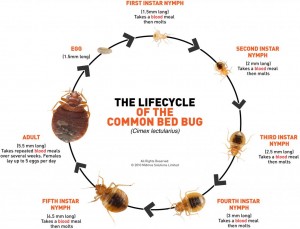Bed Bugs Fumigation in Karachi
BED BUGS CONTROL & TREATMENT SERVICES:
Bed bugs feed on blood as a single source of nutrition. It must be fed to mature adults once during all its immature stages. Adult females also need blood to produce eggs. Although humans bite bugs, it is not known to spread the disease to humans.
Bed bugs We are providing Bed Bugs Treatment in all over the Karachi. Bed Bugs can multiply quickly, so early detection is critical to help prevent an even larger infestation. Our integrated protection process works to assess your home, implement solutions, and monitor any bed bug problems you may face.
HOW TO IDENTIFY BED BUGS
Oval shaped and flat, bed bugs are about 10 mm long. They are brown before feeding, changing to red once they feast on human or animal blood. Younger bed bugs are smaller and lighter colored but also turn dark and red after feeding. They cannot jump from place to place and, because they are wingless, cannot fly, and smooth metal or other polished surfaces are a challenge for them to climb. The eggs of a bed bug are white, roughly a millimeter long and not easily detected by the human eye.
Bed Bugs Inspection:
If you have seen evidence of bed bugs or want to help protect your home against this multiplying intruder, Perfect Pest Control will come and inspect your home. Bed bugs are sneaky and hard to find, but our Perfect Pest Control staff are trained to pinpoint evidence if they are around. On the first visit, we will examine your entire home including the bed, furniture, rugs, and linens. we will conduct an inspection of target areas, and if required, use tools to check cracks and crevices. We will usually start in the bedroom and work his way through your home, concentrating on the furniture and the areas immediately surrounding the furniture. we will look for signs of bed bugs including:
- Live bed bugs
- Skins cast off during the molting process
- Small spots of reddish-black fecal material
- Tiny cream-colored eggs usually found in dark crevices.
- Bed bugs are sneaky and hard to find, but we are trained to pinpoint evidence.
Implementation:
Upon completion of the inspection and an assessment of the situation, we will recommend the best course of action. If the inspection confirms an infestation, we will recommend a treatment plan based on the severity of the infestation and your preferences. we will use the best tools and science to address the causes and treat your bed bug problem in the best way for your family, pets, and the environment. This implementation method targets bed bugs as well as the bed bug larvae — preventing them from maturing into breeding, biting, and potentially disease-carrying adults.
we will recommend the best course of action.
Monitoring
Bed bugs never sleep, and unfortunately, they can visit any time without notice. Professional treatments can take One to Two visits to eradicate the problem. Because early detection is so critical, We can come back periodically to monitor your home and help prevent an infestation. During these visits he will also check for new pests while making sure bed bugs have not arrived unannounced. If he sees something new or suspicious, he will investigate. we will document your progress and any problems that may arise to ensure the best maintenance approach for your home.
Bed Bugs Species:
Bed bugs shouldn’t be confused with dust mites. Bed bugs are nocturnal parasitic bugs that feed on blood from warm blooded mammals
Dust mites are microscopic spiders that feed on shed dead skin cells. Dust mites are not visible to the eye.
Appearance:
• Bed bugs are around 4 to 5 mm long.
• Oval and flattened from back to underside with thick, well-developed legs. Bed bugs do not have wings.
• Their mouths are pointed for piercing and sucking.
• Adult bed bugs are red to brown in color.
• Eggs are whitish cream, getting darker as they hatch to larvae.
• Their shed skins are lighter brown and look like flaky exoskeletons.
Bed Bugs Life cycle:
• Bed bugs lay 200 – 500 eggs over a 2 month period in batches of 10 to 50.
• The eggs are attached to items of furniture or fittings in clusters by a transparent substance
• There are 5 stages to the life cycle from egg to fully grown adult which can be from 6 to 10 months
• The typical life span of a bed bug is about 10 months.
• They can survive for weeks to months without feeding.
Bed Bugs Habits:
• Bedbugs feed on human blood and are attracted to body heat and CO2 from sleeping humans
• They inject an anesthetic when they pierce the skin, so the bite can go unnoticed at first
• They are found in cracks and crevices, headboards, behind peeling wallpaper, broken plaster, light switches, under carpets and skirting boards etc. so they are near to people for feeding
• Bed bugs are nocturnal and start feeding soon after sunset and before dawn
• Bed bugs will feed during the day if conditions are favourable
• When alarmed they move quickly and emit an odour
• We’re not Satisfied until you’re Satisfied.






